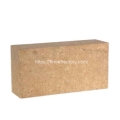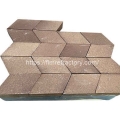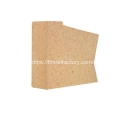- Performance. Innovation. Worldwide. Your trustworthy Refractories Manufacturing Partner--Fireramo
- +86 175 3769 7777
Silica ramming mass for induction furnace lining
- Category: Refractory Ramming Mass
- |
- Author: Fireramo
Silica Ramming Mass is an acidic refractory material. It is a commonly used refractory for induction furnace linings. The use of Silica Ramming Mass to build induction furnace linings protects the induction furnace lining from high temperatures and chemical reactions.
- SiO2: ≥95%
- Al2O3: ≤0.7
- Fe2O3: ≤0.5
Search
Contact
High quality refractory bricks
Related products
Product Details
Silica ramming mass for induction furnace refractory lining
Silica ramming mass description
Silica ramming mass is an unshaped refractory material made from a mixture of high purity microcrystalline quartz sand, powder, high temperature sintering agent and mineralizing agent. Silica ramming mass is an acidic ramming mass with good volumetric and thermal stability, which is mainly used as lining of induction furnaces and as filler for the inner lining of electric furnaces and casting furnaces.
As a manufacturer of Silica ramming mass, Fireramo can provide you with Silica ramming mass with stable performance and reliable quality. Moreover, we sell our refractory materials at favorable prices worldwide.

Characteristics of Silica ramming mass
Good refractory properties
Silica ramming mass has a high melting point and excellent refractoriness, a characteristic that ensures that it remains stable at high temperatures in the furnace without softening or melting.
Good thermal stability
Silica ramming mass has good thermal stability, it can withstand rapid and extreme temperature changes without cracking or flaking. This is important in induction furnaces where temperature fluctuations are common during the heating and cooling cycles.
Low thermal expansion
Silica ramming mass has a low coefficient of thermal expansion, it expands and contracts very little during temperature changes and has good volume stability.
Chemical Stability
Acid silica ramming mass is chemically stable and has good resistance to acidic and alkaline slags produced during the melting process. It does not react with molten metal or other furnace materials, thus ensuring the stability and service life of the furnace lining.
High density
Silica ramming mass has a high bulk density, which contributes to its strength and resistance to erosion and penetration by molten metal or slag. The high density also contributes to a compact and stable furnace lining structure.
Good thermal conductivity
Silica ramming mass has reasonable thermal conductivity, which effectively transfers the heat from the molten metal to the furnace wall, resulting in an even temperature distribution inside the furnace.
Easy to install
Silica ramming mass can be easily installed in the furnace lining by means of the tamping technique, i.e. compacting and tamping it into place between the furnace shell and the induction coil. Its shape and form can be adapted to different furnace designs and configurations.
Applications for Silicon Tamping Compound
Induction furnace linings
Silica ramming mass is used to form a protective lining inside induction furnaces. It forms a dense cohesive layer that resists the corrosive effects of molten metal, slag and high temperatures. The ramming mass acts as a barrier between the molten metal and the refractory wall, preventing damage to the furnace structure.
Steel production
Silica ramming mass is widely used in the steelmaking process. Both coreless and channel induction furnaces use silica mass to melt and refine steel. The ramming mass lining helps to maintain the required temperature and prevents slag penetration, thus ensuring the production of high quality steel.
Non-Ferrous Melting
Silica ramming mass can also be used in induction furnaces to melt non-ferrous metals such as copper, brass, aluminum and their alloys. Its excellent thermal insulation and resistance to chemical reactions ensure efficient and controlled melting of these metals.
Foundries
Foundries use Silica ramming mass in a variety of applications. it is commonly used as a lining material for crucibles, ladles and other equipment in metal casting processes. Silica ramming mass protects the refractory lining from corrosion by molten metal and slag, thereby extending the life of the equipment.
Glass industry
Silica ramming mass is used in the glass industry. It is used in the lining of glass furnaces to withstand the high temperatures and corrosive conditions of the glass production process. The ramming mass lining helps to maintain thermal stability, prevent contamination and extend furnace life.
Silica ramming mass Specifications
Item | CN-1 | CN-2 | CN-3 | CN-4 | CN-5 | |
Chemical composition(%)
| SiO2≥ | 95 | 96 | 96 | 97 | 90 |
Al2O3≤ | 0.7 | 0.6 | 0.6 | 0.5 | 0.4 | |
Fe2O3≤ | 0.5 | 0.5 | 0.4 | 0.4 | 0.8 | |
Cold crushing strength (Mpa) | After firing at 1300℃×3h | 15 | 15 | 10 | 10 | 25 |
Apparent porosity (%) | After firing at 1300℃×3h | 26 | 26 | 25 | 25 | 23 |
Linear changing after burnt(%) | After firing at 1300℃×3h | 0~+1.6 | 0~+1.2 | 0~+1.0 | ||
Bulk density (g/cm3) | After firing at 1300℃×3h | 2.0 | 2.0 | 2.1 | 2.1 | 2.2 |
Refractoriness(℃) | 1630 | 1650 | 1650 | 1680 | — | |
Max. grain size of aggregate(mm) | 5 | 4.5 | 4.5 | 4.2 | 4.2 | |
Amount for construction(kg/m3) | 2300 | 2300 | 2300 | 2400 | 2400 | |
Specializing in refractory materials for over 20 years, we provide professional refractory solutions for the global high temperature industry.
Theme By Fireramo





